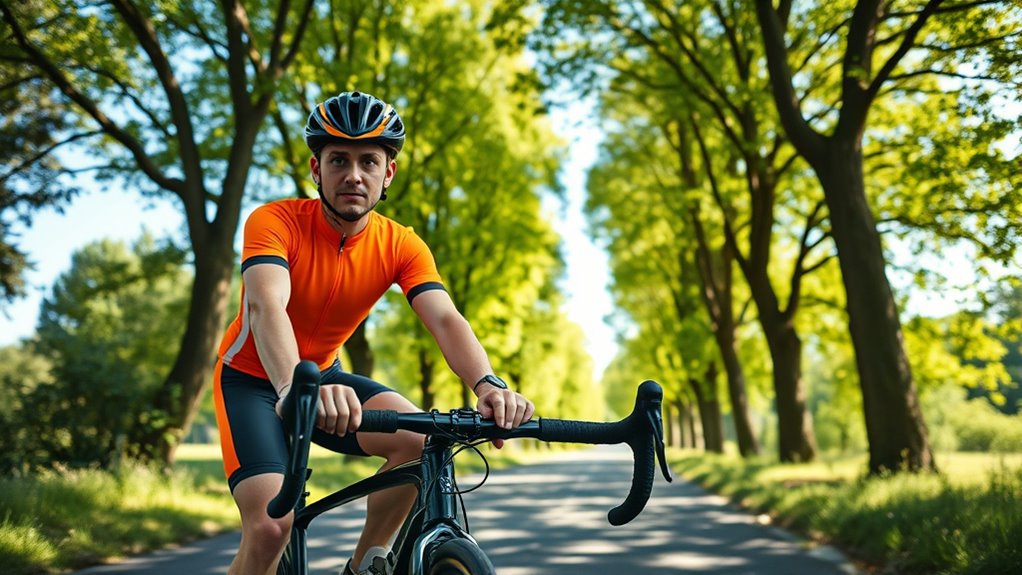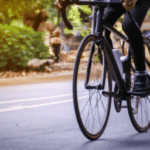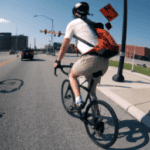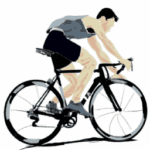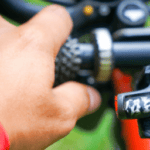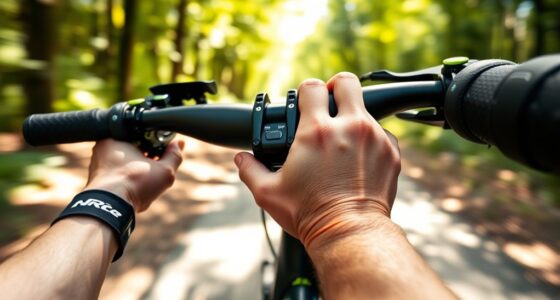Getting started with cycling is easy when you choose the right bike and safety gear, like a helmet, lights, and appropriate clothing. Learn basic skills such as shifting gears smoothly, maintaining a steady cadence, and handling traffic confidently with clear signals and proper lane positioning. Establish a beginner training routine, practice in safe environments, and join local cycling groups to stay motivated. Keep your bike well-maintained, and you’ll build confidence and enjoy riding more—there’s much more to explore ahead!
Key Takeaways
- Choose a suitable bike and safety gear, ensuring proper fit and comfort for your riding style and terrain.
- Learn essential traffic rules, hand signals, and safe riding practices to navigate roads confidently.
- Develop a beginner training routine with regular rides, gradually increasing duration and intensity.
- Use cycling apps and join local groups to find safe routes, gain support, and build confidence.
- Regularly inspect and maintain your bike to ensure safety, performance, and longevity.
Choosing the Right Bike and Gear
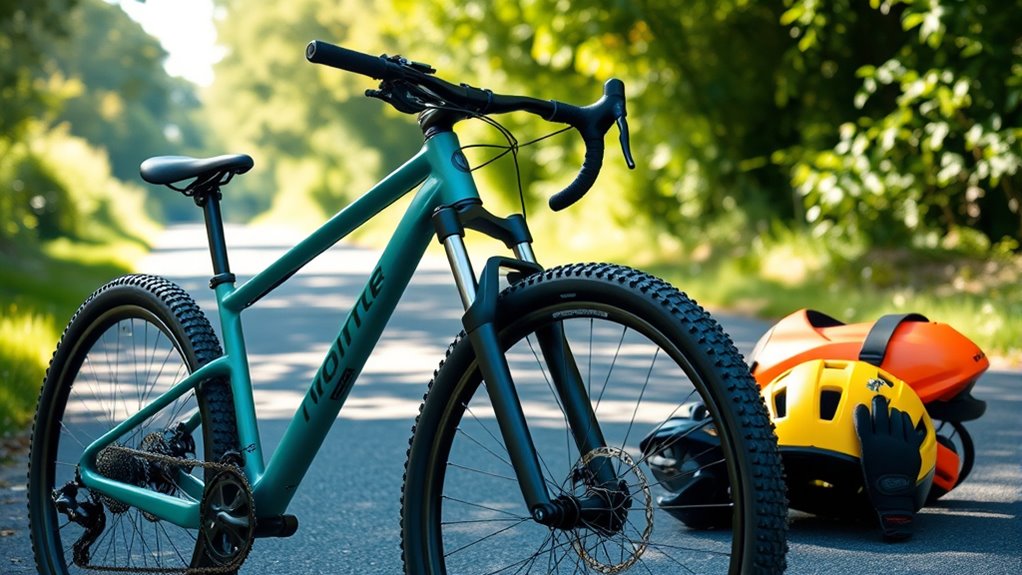
Choosing the right bike and gear is essential to guarantee a comfortable and enjoyable riding experience. First, pick a bike that matches your riding style and terrain. Road bikes are best for speed on paved surfaces, while mountain bikes handle off-road trails. Hybrid bikes are versatile for commuting and casual rides, and city bikes offer extra features like racks for urban commuting. Consider your budget—entry-level bikes suit beginners, mid-range offer better components, and high-end bikes are for serious cyclists. Make sure the bike fits your body size; a proper frame, seat, and handlebar adjustment improve comfort. Test ride different models to find what feels best. Additionally, choosing a high-quality bike with durable tires can greatly enhance your riding experience and reduce maintenance needs. Also, invest in essential gear like a helmet, lights, and comfortable clothing to enhance safety and enjoyment on your rides. Understanding your personality traits can also help you select the most suitable cycling activities and gear to match your personal preferences and motivations. Proper bike maintenance is crucial for safety and longevity, so familiarize yourself with basic upkeep routines.
Essential Safety Practices for New Cyclists
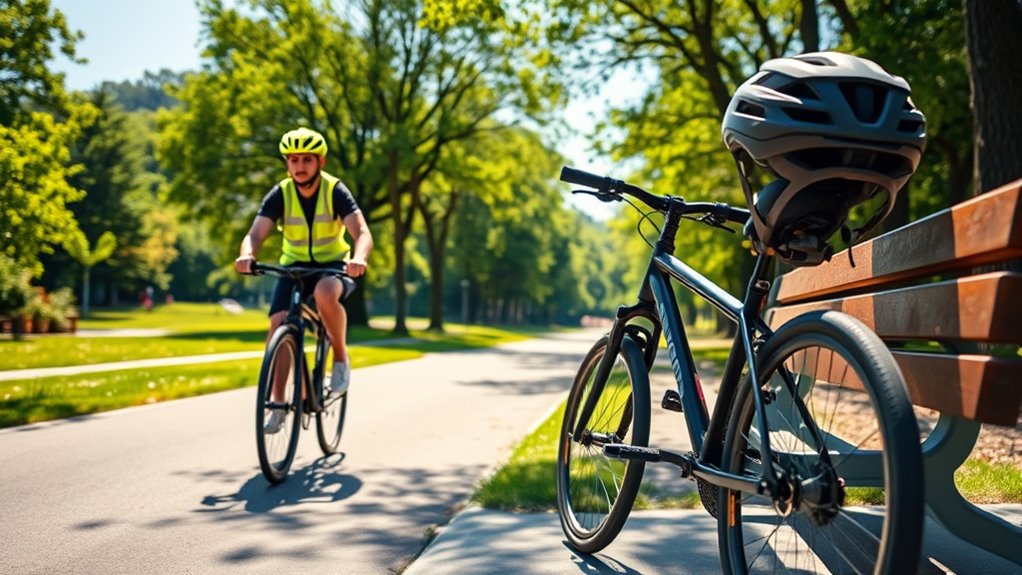
Once you’ve selected the right bike and gear, focusing on safety practices helps guarantee a smooth and secure ride. Ride single file to allow safe passing and improve lane visibility for motorists. Stay in the rightmost lane, following traffic signals and stop signs, and avoid right-turn lanes when continuing straight—merge left early. Proper bike maintenance ensures your bike functions safely and efficiently during each ride. Position yourself outside door zones near parked cars, maintaining at least three feet distance. Use hand signals to communicate lane changes or obstacle avoidance, and avoid sudden swerves—check surroundings first. Wear reflective clothing or accessories, especially in low-light conditions, to boost visibility. Regularly inspect your brakes, tires, and gear functionality before riding. Understanding traffic laws in your area can further enhance your safety on the road. Familiarize yourself with headphone use guidelines to stay alert and aware of your environment. Ride defensively, stay alert for hazards, and choose routes with bike lanes or wide shoulders whenever possible. To enhance your safety, familiarize yourself with bike-friendly environments, such as designated lanes and quiet streets, to reduce risks during your ride. Additionally, being aware of credit card security practices can help protect your personal information when making purchases online related to cycling gear or accessories.
Mastering Shifting Techniques and Maintaining Cadence

Mastering shifting techniques and maintaining a steady cadence are key to riding smoothly and efficiently. Always shift one gear at a time to prevent drivetrain damage and guarantee seamless transitions. Use your left shifter for major terrain changes, like hills, by adjusting the front derailleur, and the right shifter for fine-tuning your pace through the rear cassette. Pedal lightly during shifts to reduce stress on the chain and avoid cross-chaining, which can cause wear. Aim to keep your cadence between 60-90 RPM, shifting preemptively before terrain changes to maintain momentum. Use easier gears to sustain higher cadence and reduce leg fatigue, especially on climbs. Practice smooth, deliberate shifts, and regularly check your drivetrain to prevent issues like chain slippage or grinding noises. Applying proper application timing for your pimple patches can enhance their effectiveness and contribute to clearer skin over time. Additionally, staying attentive to your gear selection helps optimize your energy expenditure and prolongs the lifespan of your drivetrain components.
Developing a Beginner Training Routine
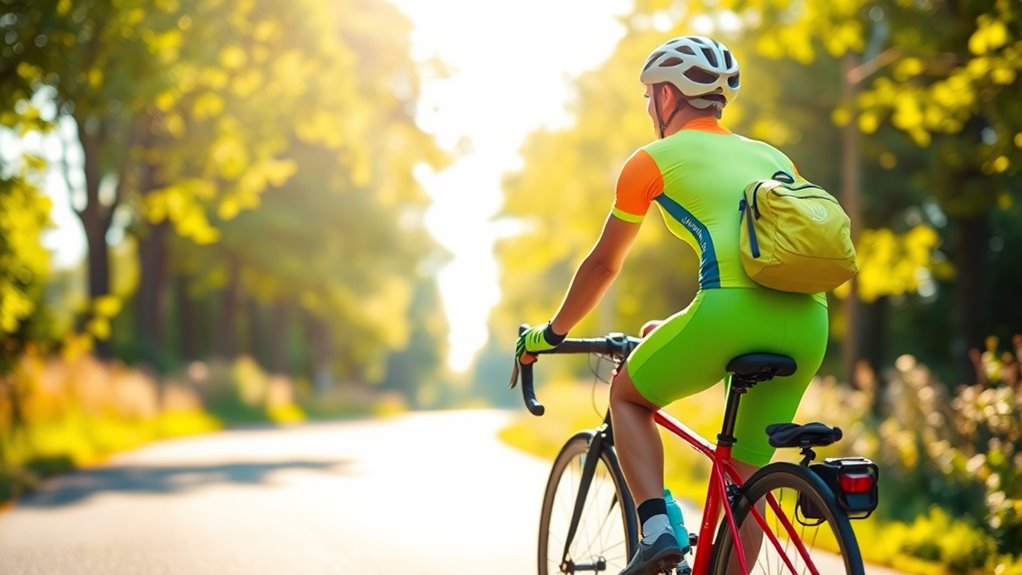
Starting a beginner training routine is all about establishing consistency and building a solid foundation. Aim to cycle 2–3 times a week for 2–3 hours total. Consistency helps turn riding into a habit within two to three weeks, so stick with it. Incorporate rest days—two per week—to allow your body to recover. Begin with low-intensity rides; gradually increase both duration and difficulty. Listen to your body and adjust your routine as needed. Start with short rides of 10–20 minutes, then slowly extend them to 30 minutes or more. Focus on maintaining a steady pace, and don’t rush progress. Building endurance takes time, so stay patient and enjoy the process as you develop confidence and strength. Choosing the right training routine can help you stay motivated and prevent injuries, especially as you build your cycling endurance. Proper gear and equipment such as helmets and comfortable clothing can also enhance your safety and comfort during rides. Incorporating proper training techniques can further enhance your performance and safety. Additionally, exploring local water parks can be a fun way to relax and stay active during rest days or after your rides. To optimize your progress, understanding celebrity transformations related to athletic pursuits can offer inspiring examples of dedication and resilience.
Effective Commuting Strategies for Beginners
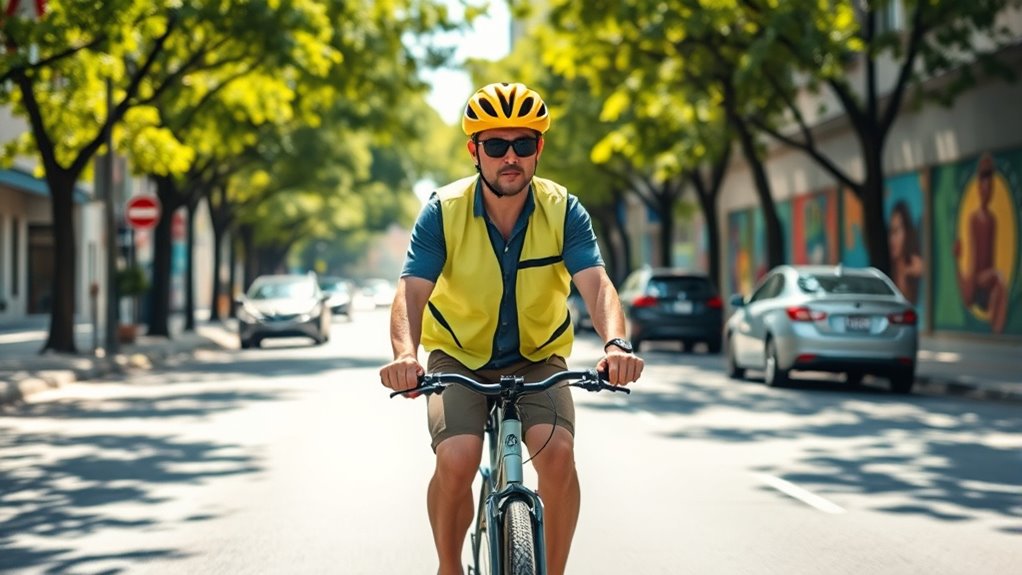
Planning your cycling route carefully can make your commute safer and more efficient. Use cycling apps like Komoot or Ride with GPS to find low-traffic roads and bike lanes. Incorporating knowledge of safe cycling practices can further enhance your safety on the road. Before your first ride, do a practice run on weekends to gauge route duration and spot hazards. Familiarize yourself with local cycling laws, including hand signals and right-of-way rules, to stay safe and compliant. Wear reflective gear and lights, especially in low-light conditions, to boost visibility. If possible, avoid busy roads—even if it adds time—to reduce risk. Choose a functional bike initially, upgrading for comfort later. Perform pre-ride checks like tire pressure and brakes, and consider puncture-resistant tires for fewer flats. Being aware of local store hours can help you plan errands efficiently and avoid unnecessary trips. Checking the retail hours today for nearby stores can save you time and prevent unnecessary detours. These strategies will help you commute confidently and securely.
Building Confidence and Improving Skills
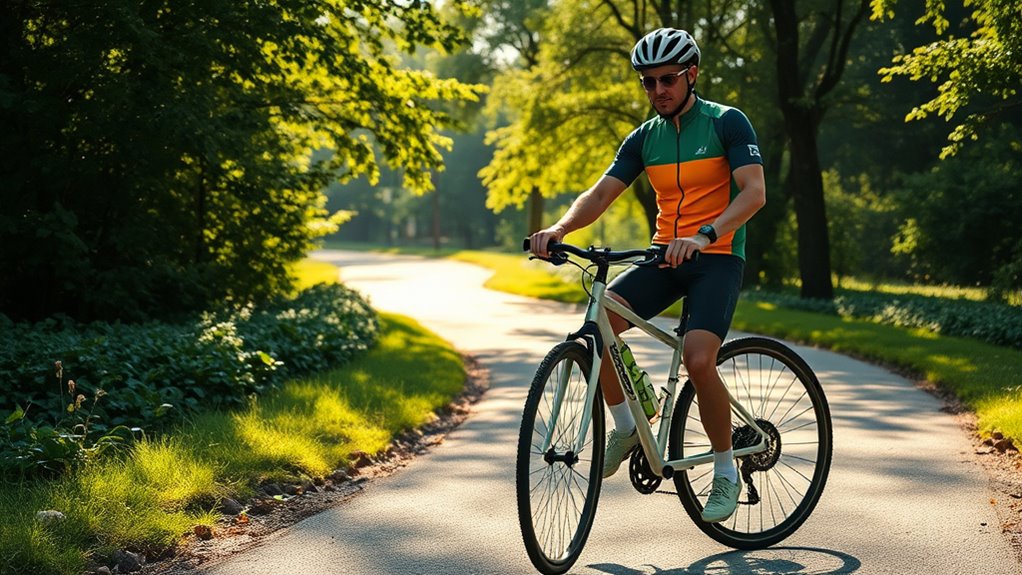
Building confidence and improving your skills on a bike come down to practicing key techniques consistently. Start by mastering starting and stopping, focusing on smooth mounting and dismounting, shifting your body weight forward when stopping, and pre-loading pedals to pick up momentum. Incorporate proper exfoliation techniques to maintain healthy, clear skin that can boost your confidence in your appearance. Developing an awareness of your surroundings can also enhance safety and self-assurance while riding. Practice emergency stops in safe areas to sharpen your reaction time and braking accuracy. Use an upright posture when stationary to stay balanced without unclipping. To climb efficiently, adjust gear ratios beforehand, alternate seated and standing positions, and focus on rhythmic breathing. Lean slightly forward on steep inclines to keep control. On descents, shift your weight rearward, feather your brakes, and scan for hazards. Incorporating precious metals investment knowledge into your understanding of assets can also help you build confidence in your financial decisions. With consistent practice of these techniques, you’ll build the confidence needed to handle various riding situations comfortably.
Tips for Navigating Traffic and Staying Safe

Managing traffic safely while cycling requires awareness of your surroundings and proactive positioning. Ride in the right third or middle of the lane to boost visibility and discourage unsafe passing. Avoid hugging the curb to prevent dooring accidents and debris.
Cross multi-lane roads one lane at a time, scanning and signaling each move. Adjust your lane position based on your speed—use the center lane if matching traffic flow or the right lane if you’re slower.
Stay outside door zones when near parked cars to avoid sudden opening doors. At intersections, scan, signal early, and merge into the correct lane before reaching the intersection.
Assume drivers mightn’t see you, and always communicate your intentions with clear hand signals. Obey traffic signs and lights, and wear high-visibility clothing for added safety.
Maintaining Your Bike for Longevity and Performance
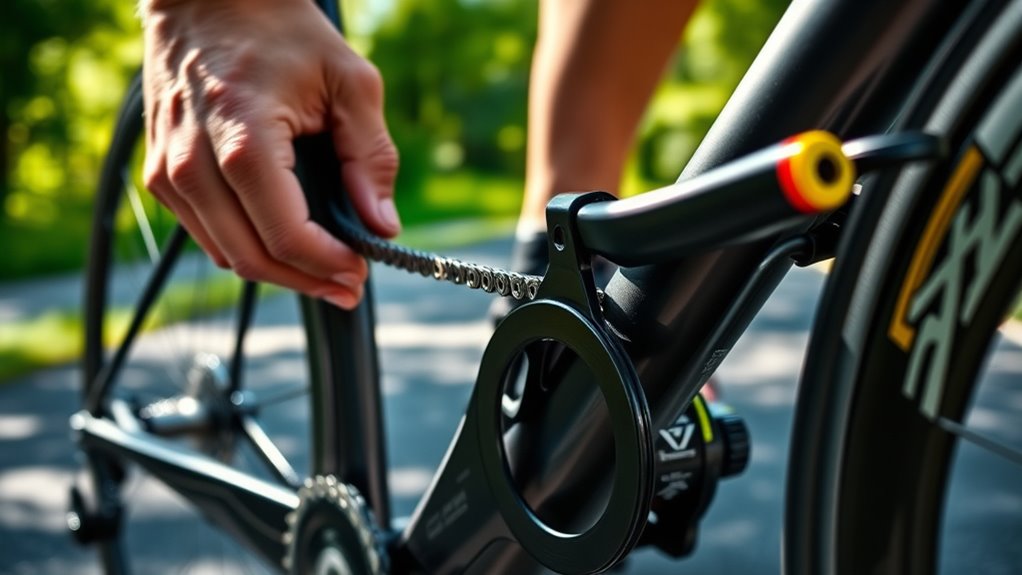
Regularly maintaining your bike is essential to guarantee it performs reliably and lasts longer.
Start with a pre-ride inspection: check tire pressure to prevent flats, verify quick-release mechanisms for wheels and seatposts, and test brake responsiveness. Look for cracks or damage on the frame and fork.
After rides, clean your bike by degreasing the chain and cassette, wiping the frame, and avoiding pressure washers that can damage bearings.
Keep the drivetrain smooth by lubricating the chain, checking derailleur pivots, and inspecting chain stretch.
Regularly examine tires for debris, sidewall cracks, and rim tape integrity, rotating tires if possible.
Annually, overhaul bearings, replace brake cables, and swap brake pads as needed.
Store your bike in dry conditions and apply protective coatings to prevent rust.
Joining the Cycling Community and Finding Support
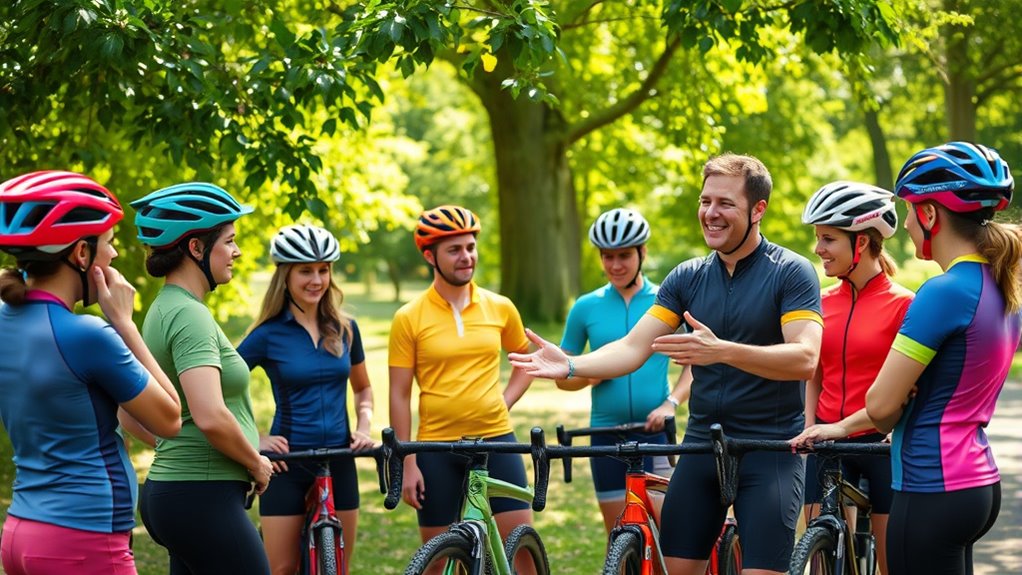
Connecting with other cyclists can boost your enjoyment and motivation, making your riding experiences more rewarding. Local cycling groups, like Meetup chapters such as “Bicycling Beginners” or “Beginner Cycling,” offer structured rides and social events in your area. Groups like Valley Epic Rides in Phoenix or Greenway Cyclists in Cary help you build skills while meeting new friends.
There are also senior-focused groups like “Senior Cycling Atlanta” that cater to different needs and paces. Online communities like Love to Ride and Strava connect you with riders worldwide, track your progress, and provide challenges.
Joining these groups and platforms gives you support, encouragement, and opportunities to learn, making your cycling journey more enjoyable and sustainable.
Frequently Asked Questions
How Do I Choose the Right Bike Size for My Height?
When choosing the right bike size for your height, start by measuring your height and inseam accurately.
For road bikes, look for a frame size close to your inseam (in cm). If you’re between sizes, opt for the smaller or larger one depending on your riding style.
Always test ride if possible, and check standover clearance and reach to guarantee comfort.
Proper fit makes your ride safer and more enjoyable.
What Should I Do if I Get a Flat Tire Unexpectedly?
If you get a flat tire unexpectedly, stay calm and find a safe spot to stop.
Carry essential tools like a spare tube, tire levers, and a pump.
Release the brakes, remove the wheel carefully, and deflate the tube completely.
Use levers to pry off the tire, locate and fix the puncture, then reassemble everything.
Inflate the tire to the proper pressure before riding again.
Are There Specific Clothing Tips for Riding in Cold or Rainy Weather?
Dressing for cold or rainy weather is like layering a protective shield around you. You should wear moisture-wicking base layers to stay dry, insulating mid-layers for warmth, and waterproof outer layers to block wind and rain.
Don’t forget thermal tights, waterproof shoes, and gloves. Bright, reflective gear enhances visibility, while proper tires and lights improve safety.
Adjust layers as needed, and always prioritize comfort and protection.
How Can I Improve My Cycling Stamina Over Time?
To improve your cycling stamina over time, you should set realistic goals based on your current fitness. Gradually increase your weekly riding volume, focusing on consistent, moderate efforts.
Incorporate longer, low-intensity rides to build endurance and add interval training like sprints and hill repeats to boost power. Prioritize recovery, stay hydrated, and fuel properly.
Consistently challenging yourself with varied workouts helps your body adapt and enhances your stamina effectively.
What Are Common Mistakes to Avoid as a Beginner Cyclist?
As a beginner cyclist, avoid common mistakes like wearing ill-fitting gear, which causes discomfort, and neglecting helmet safety, reducing protection.
Don’t forget essential tools and locks to prevent issues and theft.
Use brakes gently, shift gears correctly, and unclip pedals at stops to prevent falls.
Maintain proper posture, stay hydrated, fuel well, and keep your bike clean.
Follow traffic laws and use visibility aids to stay safe on every ride.
Conclusion
Now that you’re armed with all these cycling secrets, you’re practically unstoppable on two wheels! Imagine effortlessly cruising through traffic, conquering hills like a superhero, and turning heads everywhere you go. With your new skills and confidence, you’ll transform into a cycling legend in your neighborhood. So gear up, hit the road, and get ready to leave everyone in awe—because when you ride, nothing can stop you!
